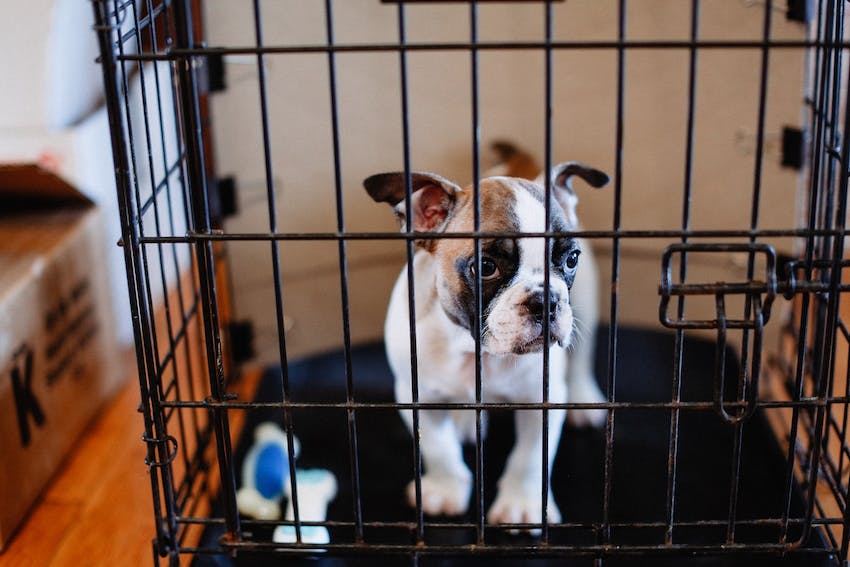Ready to help treat your pet to a healthy life?
How to Crate Train a Puppy
By : Kelli Rascoe & Trupanion Staff | Updated May 30, 2024

As a new dog owner, you’ve likely heard enough training and care tips to last a lifetime. But in this sea of advice, training your puppy in a crate early on is the one that stands out. As your pet grows, a crate can be a cozy spot to relax and de-stress; in certain situations, it can also be a place of safety.
Of course, most dogs need some practice in being able to go in and stay in a crate comfortably and without fuss. To get the most out of a dog crate, it's important to start crate training as soon as possible and with the right methods.
Why it's important to crate train a puppy
Though some people view dog crates as putting one’s pet in a cage, the plain and simple truth is that crates can be a positive experience for pet owners and pets alike. Just like humans, dogs need a safe, quiet space where they can unwind — dog crates are the perfect solution. Beyond comfort, a crate can be a useful tool for housetraining and preventing destructive behavior. They're also commonly used during travel and overnight veterinary stays. Puppies who are already used to being in a crate may be less anxious in these situations.
"Crate training can be an efficient way to housebreak a puppy," says Trupanion veterinarian Dr. Caroline Wilde. "It can give the puppy a safe place to go where they feel secure and comfortable. Furthermore, this can help the puppy be at ease when they need to be crated for confinement purposes, like when leaving the house for a period of time, or when you have company over,”
Of course, puppy crate training must be done correctly in order for these benefits to exist. The right kind of crate must also be selected for your dog’s comfort and safety.
What kind of dog crate do I need?
Dog crates come in all shapes and sizes, and finding the right size and style for your puppy is step one. The first thing to consider is the crate material, each of which has unique advantages:
- Wire: portable and collapsible for easy storage
- Mesh: good for travel, but not as sturdy
- Plastic: durable and comfortable
Like harnesses, collars, and leashes, size is another important factor in a crate. A crate should be big enough for your puppy to stand up, turn around, and lie down with ease. If a crate is too big, it may prompt your puppy to have accidents inside it. Some puppies may need a crate upgrade as they grow.
Not sure how big your pet is going to get? Your veterinarian may be able to offer extra guidance when it comes to finding the best puppy crates.

7 tips for crate training a puppy
Getting the hang of crate training can be tricky at first. Use these tips to simplify the process for you and your pup.
1. Start slow
Your puppy's introduction to the crate should be a gradual one. Start by letting your dog explore it on their own terms with the door open. As they grow more comfortable with the crate, you can begin coaxing them into it with treats and toys. If your puppy seems wary at first, don't force it. Even if they don't warm up to the crate for several days, taking your time will prevent them from viewing it negatively.
Letting your puppy eat meals inside the crate can help them feel more comfortable in the space and might speed up this process. Many pet owners choose to keep crates in rooms with high activity. Puppies often prefer these areas for their closeness to other members of the house.
2. Get moving
Puppies should get plenty of exercise before crate time. Research suggests that physical activity can reduce fearfulness and anxiety in puppies. This comes in handy when introducing them to a crate, which can be nerve-wracking for a young pup.
Engaging in exercise with your puppy can also strengthen your emotional bond. This is likely to make them more comfortable facing the unknown as long as you're there. Opt for activities like hiking or agility practice to strengthen your dog's mind and body.
3. Mind the time
When you start leaving your puppy in the crate, keep an eye on the clock. Young dogs haven't yet mastered control of their bladders, so they'll need to be let out to relieve themselves. As your puppy grows, they can stay in the crate for longer periods. Depending on their age, here's how long they can spend in a crate:
- 8-10 weeks: up to 60 minutes
- 11-14 weeks: 1-3 hours
- 15-17 weeks: 2-4 hours
- Over 17 weeks: 4-5 hours
4. Give rewards
Treats and praise are key crate training tools. Keep the rewards flowing as your puppy gradually warms up to the crate. This helps them develop positive feelings toward the crate, reducing anxiety and wariness. When you're not training, leave the crate's door open. If your pup enters it unprompted, give them a treat to encourage the behavior.
5. Provide activities
Puppies enjoy crate time more when they have something to do. Leave your puppy with activities to work on while they're in the crate. This can mean toys or puzzles that have hidden treats inside. If crate time and meal time overlap, your puppy can even take their meals from the space. Consider asking your veterinarian which items your puppy can safely chew unsupervised.
6. Keep it positive
Helping your dog view their crate positively is one of the most important parts of training. Negative reinforcement can make puppies stressed and anxious. If your puppy is stressed during crate time, it can make the process much harder. Even if your puppy takes a while to warm up to the crate, avoid using force or scolding them for being wary.
Additionally, never use crate time as a form of punishment. This may confuse your puppy, who once thought of the crate as a safe space. A negative perspective of the cage can be hard to reverse, so try to ensure most interactions with the crate are good-natured. Putting your puppy in their crate to get ahead of mishaps, such as before guests come over, is more effective.
Keep in mind that treats are certainly one option for positive reinforcement, but too many can set up false expectations (not to mention contribute to obesity). Verbal praise and pets can be highly effective as well and foster a welcoming, pleasant environment.
7. Foster independence
As your puppy begins to spend more time in their crate, start stepping away for a few minutes. Gradually increasing the time spent away gives your dog the chance to practice independent crate time, without making them feel isolated. Before you leave and after you return, avoid being overly emotional. Giving praise is encouraged, but too much fuss can make it harder to normalize crate time.
With patience and plenty of treats on hand, crate training can be a rewarding process. Though it takes time and effort, giving your puppy a space of their own has long-lasting benefits. Plus, you'll get to spend some more quality time with your newest furry friend.

Protect your puppy’s health throughout training
Even with the best safety measures in place during puppy training, you can’t predict what they’ll get into or when. They’re also at a pivotal time in their life where they’re exploring and getting to know the world — this is certainly exciting, but it brings with it a lot of risks to their health. So, as you learn how to train and care for your puppy, there's no better time to explore pet insurance. Signing up early will help ensure you get the most of your pet’s coverage as they grow.
